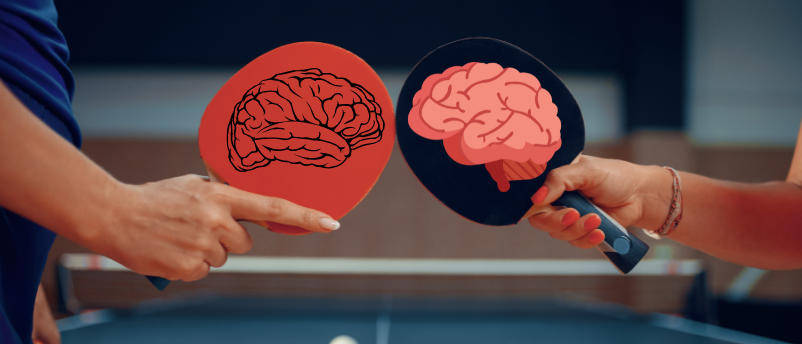
BioTechniques News
Aisha Al-Janabi

New research suggests brains require more cognitive effort to play table tennis with a robotic ball machine than against a human.
Researchers studying people playing table tennis have found that their brain activity varies when playing with a ball machine compared to a human opponent. While waiting for a human to serve, the players’ neurons acted as one whereas waiting for the robot to release the ball led to a more scrambled response. The team believes that understanding the difference in brain response has implications for both sports training and attempts to make robot assistants more naturalistic.
Senior author Daniel Ferris’s research group at the University of Florida (FL, USA) has researched brain responses to visual cues and motor tasks for several years. While their prior research has focused on simpler tasks such as walking and running, the researchers were interested in developing this approach to focus on faster and more complex actions. The researchers settled on table tennis as the motions are dynamic yet less oversized than alternatives such as tennis.
“It takes all your senses – visual, vestibular, auditory – and it gives information on creating your motor plan. It’s been studied a lot for simple tasks, like reaching and grasping, but all of them are stationary,” lead author Amanda Studnicki said. She explained that table tennis is suited to understanding how motor plans function “for complex movements like tracking a ball in space and intercepting it.” Motor planning is a set of processes that occur in the preparation of a movement before engaging in a motor activity.
 When a tree is stressed in the forest, does it make a sound?
When a tree is stressed in the forest, does it make a sound?
Scientists have recorded plants releasing ultrasound when under stress indicating that plants do, under certain stimuli, make sounds all on their own.
In the study, 37 research participants played table tennis for an hour whilst wearing a brain activity cap. The time playing was split into 15-minute blocks where the participants spent half the time playing competitively or cooperatively with a human and the rest facing a machine feeding balls at approximately 2-second intervals.
The researchers utilized a dual-layer electroencephalography approach with a cap with 240 electrodes rather than the standard 120. The analysis focused on the pareto-occipital cortex – the region most involved in converting sensory information into movement. Researchers synchronized brain activity to sensors in the playing environment and video footage to analyze the brain activity when the players hit the ball.
The results showed that there is a difference between when the players faced human and robotic opponents. The researchers found that when players return the ball fed by a machine, it appears to require more cognitive resources than the comparable action against a human. In between shots against the human opponent, the participants’ neurons showed greater uniformity – or synchronization – and characteristic signs of cortical idling but this was not found when playing against the ball machine.
One suggested reason for this desynchronization is that the lack of body language cues from the machine means that the brain stays activated rather than relaxing until it observes the visual cue to prepare. Alternatively, the novelty of the table tennis ball machine might explain the signs of continued higher activity.
The researchers plan to study the differences between these responses further. In terms of the sporting implications, Studnicki said, “I still see a lot of value in practicing with a machine. But I think machines are going to evolve in the next 10 or 20 years, and we could see more naturalistic behaviors for players to practice against.”
Ferris hopes to understand the broader implications of the different responses. Considering the potential for socially assistive robots to support older people, he commented that “humans interacting with robots is going to be different than when they interact with other humans. Our long-term goal is to try to understand how the brain reacts to these differences.”
The post Is playing table tennis against a robotic opponent more challenging for your brain? appeared first on BioTechniques.
Full BioTechniques Article here
Powered by WPeMatico
